Cameras have sometimes been described, modestly, as boxes onto which lenses are attached. Some of these boxes change the way we shoot motion pictures, especially when they are lighter, smaller, and faster. Technology influences technique, and two new cameras were introduced by Canon at an exclusive event in the Paramount Theater on November 3. They are the Canon Cine EOS C300 and C300 PL 35mm digital motion picture cameras.
The story began over 3 years ago. Canon introduced the EOS 5D Mk II in September, 2008. It was designed for photojournalists to shoot stills and put short 30 second clips onto the web. The rest is history. The 5D was embraced by Hollywood, Bollywood, and by everyone else who liked the look of 24×36 mm format video images.
Canon subsequently introduced the APS-C (22.2 x 14.8 mm) EOS 7D and APS-H (28.7 x 19 mm) EOS 1D Mk IV, and you could hear the machine shops worldwide chopping off the front and installing PL mounts. Mostly in Munich at FGV Schmidle, Denz and Hot Rod Cameras in Hollywood.
Canon did not attack one of their DSLR still cameras with a Dremel or bandsaw to create the camera shown today. This is a totally new style of digital cine camera. Actually two cameras. PL mount (above, left), and EF mount (above, right).
Why 2 mounts and not a neutral mount with adaptors? Canon explained that it saves on cost, complexity and insures consistent flange focal depth. Also, remember that the EF mount has all the Canon electronics and contacts in it. The bodies are dustproof and splashproof.
Although PL lenses are one of the worldwide standards, they pale in comparison with the 70 million EF lenses delivered so far by Canon. About a year ago, I was asked by Mr. Hitoshi Doi of Canon USA which of the 2 choices I would make if confronted with a new cine camera. I thought PL at first, then hemmed and hedged and could not decide. Mr. Doi smiled and said, “I hope you will not be disappointed by what we may show you in a year from now.”
Canon will initially introduce 3 EF mount cine-style prime lenses: 24 T1.5, 50 T1.3, 85 mm T 1.3.
When Canon designed the C300, they wanted to keep the small form factor of the DSLRs, but to make it a true cine camera. They didn’t want to lose the things that people liked about the EOS 5D, 7D, 1D.
Key ingredients:
- Exposure index from 100 – 20,000 ISO (ASA, EI). Yes, 20,000.
- Speeds down to 1 fps
- Shoots true 24.00p (not just 23.976)
- S35 3-perf 16:9 8.3 Megapixel sensor (around 4K) – 3840 photosites horizontal x 2160 photosites vertical. 26.6 x 13.6 mm compared with APS-C of 22.3 x 14.9 mm.
- The new C300 camera uses the same MPEG-2 codec with an MXF File Wrapper that Canon developed for their compact 3-sensor camcorder – the XF300, and XF305. This codec offers a choice of 50 Mbps 4:2:2 component , 35 Mbps 4:2:0 component, and the standard HDV format of 25 Mbps 4:2:0. Using this codec gave Canon economies of scale that allowed them to bring a very high-performance large-format single sensor camera system to market at a highly cost-effective level.
- The C300 weighs 3.15 lbs.
- Dimensions are 5.24” wide x 6.73 deep.
- Flange focal depth is 44mm from the EF mount to the image plane.
- The camera is powered by a 7.4v 4000 mA BP-955 XF battery, similar to the XF305, lasts about 4 hours. This is helpful because you don’t need big external batteries.
- This camera is dust and splash resistant like the 5D, maybe not as weatherproof as the 1D.
- Wireless remote control with iPad interface. Detachable control panel.
- Be sure to use qualified CF cards. Canon probably will have a list.
- Has connections for SDI out, genlock, timecode. With the sync port, you can sync 2 cameras together for 3D. Audio has two XLR connectors.
Color science. Canon came from an analog still camera still film background. Their scientist said they wanted to make digital look as film-like as possible. For this reason, the noise looks like grain.
The “sweet spot” for ISO according to Canon tests appears to be 850. Canon log gamma goes from 850 to 20,000.
Because of the double speed readout, rolling shutter is not an issue.
There are built-in ND filters and a clear filter between the cover glass and the sensor, to knock down up to 6 stops of exposure. These are controlled electronically, but you can move them manually in a pinch. A flat base protrudes forward under the lens to prevent tipping when the camera rests on a flat surface.
Weatherproofing: Buttons have rubber boots and dials have “O” rings, access covers have sealing flaps.
Cooling: a special sheet conducts heat from the sensor, sealed in its own dust-proof chamber, toward the heat sink. Two small, silent cooling fans move the air to vents in the body.
There are ¼-20 sockets on top, 2 tape measure hooks, and 3/8-16 tripod mounting threads on bottom. 4 start/stop switches.
A dial controls EF lens apertures. This dial can be re-programmed and used for a different function when PL lenses are used.
The center mounted high resolution viewfinder tilts 60 degrees, and pulls out from the rear. It is sharp enough to check focus.
Menus are navigated with a Select-Set dial similar to an EOS still camera.
Assignable buttons can be used for viewfinder magnification, peaking, zebras, headphone, and taking stills. These assignable functions can be stored to an SD card.
The 4” diagonal multi-angle control panel swivels 270 degrees forward/back, 270 degrees left/right and is removable. It has 1.23 million dots. It has waveform, vectorscope, and edge monitor functions.
Any web browser can access the camera’s HTTP server via WFT—so an iPad can be used to check and control camera settings. A small Liveview (476 x 268) window shows limited motion at 1 fps. On an iPhone, the Liveview is 288 x 162. With EF lenses, you can remotely focus and adjust iris with an iPad. This is helpful on cranes and remote shots.
The camera comes with plug-ins for Avid and FCP. An XF Utility can be downloaded to check shots.
The CF cards are hot-swappable. You can copy between media, relay record to extend running time, initialize a second card during recording.
There’s a 3-second pre-record function
We spoke with representatives from Canon: Larry Thorpe, Senior Director, Imaging Technologies & Communications Group; Eliott Peck, Senior Vice President & GM, Sales, Imaging Technologies & Comm Division. We also spoke with and the filmmakers who shot the films shown at the Paramount screening: Richard Crudo, ASC; Sam Nicholson, ASC and President of Stargate Studios, Felix Alcala; and Larry Carroll.
Some saw Epic similarities, others saw history going back to 1920 and the Debrie Sept. Both the Sept and C300 cameras are small, handheld, 35mm format, weighing about 3 ½ lbs. Others said the C300 reminded them of an Arriflex 16SR without the long base and magazine. If RED was the first motion picture camera based on the paradigm of a digital still camera that could shoot movies at 24 fps, the C300 is an altogether different paradigm: a lighter, faster, smaller motion picture camera that’s evolved from Canon’s experience in both stills and video.
I’ve known Richard Crudo, ASC almost forever, and I thought he was a die-hard film guy. We saw his film as a projected 35mm film-out. Richard was impressed by the C300 size, weight, sensitivity, and high exposure index. His biggest lamp was a 2K. They moved very fast, doing 50-60 setups a day..
Richard Crudo shot his dramatic crime drama “Dirty People” in 15 days. It was a low budget production. From the C300 camera’s 1920×1080 output to CF cards, they went to DI at Technicolor and film-out onto 35mm release print. Jill Bogdanowicz did the grading.
They used the 2 new Canon zooms: FK14.5-60 (14.5-60 mm T2.6) and FK30-300 (T2.9 from 30-240; ramps to T3.7 from 240-300mm). Also Canon EF prime still lenses with gears and Red Rock Micro support and follow focus. 2 CF cards recorded simultaneously to provide an “original” and a clone. Shot in 16:9 format. Film out was cropped to 1.85:1.
Richard said, “I went back to my roots of shooting fast. I could shoot at any time of day, anywhere. I thought of it as a film camera, treated it as such, used a light meter. One of the most important things was how good the DI and film out looked. We had planned a lot of time with Jill Bogdanowitz at Technicolor, but we graded it in maybe an hour.”
I asked Sam Nicholson how can something so little, and 4:2:2, can work so well for effects. His favorite thing was the C300’s sensitivity: shooting at 16,000 ISO. Other things he liked: Speed. Size and Weight. Small and Light. Most completely integrated camera. Changed the way we shot. No lights or few lights. Lit the cable car scene with iPads and flashlights.
Sam said, “This camera may change the way scenes are written. No longer will writers be discouraged from “NIGHT- EXTERIOR.” It actually may be cheaper to shoot at night—less trouble controlling daylight with big silks. We can also budget green screen with less light. This opens up a new style of shooting. More camera bodies. More creative horsepower. This camera democratizes the filmmaking process.”
Sam’s Sci-Fi project screened at Paramount, “XXIT” had lots of night shots, and had a production schedule of 5 days of shooting. 10 days overall with post. It was a normal TV schedule. “If you can shoot with 6 cameras, your can shoot faster, more angles, more set-ups. For example, the cable car, I could just grab the CU’s and inserts in the trolley.” Sam said.
Felix Alcala (Ghost Whisperers, The Other Side) was the co-director/DP of “Sword.” He said, “The battery size was a great help. It’s like a small consumer camcorder 7.4 volt battery, but was amazing because it lasted 4 hours. That meant we didn’t need big external batteries. That saved weight, so we were smaller, lighter, better, tighter. We could take the camera anywhere, not worry about the weight. This camera is going to open up the world of filmmaking for everyone. This was the first camera I could use without lights. People liked the small size of the 5D, its dimensions, usability, and ability to go stripped down where other cameras can’t go.”
Larry Carroll was also co-director/DP on “Sword.” Felix and Larry had an idea, a pitch for a TV series. They pitched the idea with pictures, visuals, like a graphic novel. Felix had worked with Canon cameras before, using an early XL-1 on a series pilot, and later Canon 5D Mk II cameras.
Their film “Sword” was shot in 5 days. Larry said they pushed the envelope with this camera. They needed less light, fewer trucks, people, equipment. They rated the camera mostly at 800 EI but one shot in the Pasadena City hall garden was at 20,000 – as an experiment, but it was included because it looked great. Most of the light was existing light. They used one 5K. Larry said, “The big deal is the quality of the image is so good. We shot 24 fps, 6 fps, 12 fps. The camera is small, lightweight. 2 cameras were set up with zooms in studio mode. 2 were ready to go in handheld mode.
Larry, who knows cameras (having been director/cameraman/producer at the respected Sundog productions) said, “So many small cameras are built up with huge rigs and become too big—bigger than the big cameras they were intended to replace. Somehow the freedom of shooting gets lost. In the early day, cameras needed to be big to impress the producers, directors and stars. When you showed up with a small camera, they said, “this can’t be a real production.” That’s changed.
I asked Eliott Peck if this camera signals a new direction for Canon.
He said, “We intend to meet the needs of the film & television production community more directly, not only through careful product design, but also through service and support, education, and listening very carefully to the wants and needs of our professional clients.
“Canon U.S.A. recently reorganized itself and created the Imaging Technologies and Communications Group. We then formed the Professional Engineering and Solutions Division to support the professional imaging industry directly in many areas including service, field support, technical help, education, research, and sales.
“We’ve shown our long term commitment by building our new Hollywood Professional Technology and Support Center in the Sunset Gower Studios. We’re coming with more than just our technology, we’re coming with a listening ear, and a lot of resources in order to make sure we are ready to support, to educate, and to service the needs of this community.”
Larry Thorpe stepped in, pointing out how Canon makes everything that goes into and onto this camera…sensor, electronics, software, lenses. Could this camera, shall we say, be “the beginning of a new relationship?”
Larry said, “It’s the beginning of a definitive new business strategy for Canon. Our entry into the 35mm motion picture world capitalizes on our having developed all of the core technologies of a digital acquisition system to a level where we can squarely address multiple high-end digital production needs within the global marketplace.”
Lenses
I heard at PhotoPlus Expo that Canon has delivered more than 50 million Canon EOS cameras and 70 million EF lenses. Yet they’re offering the C300 camera with a choice of EF or PL mount. I talked with Larry Thorpe about lenses: the 70 million EF still camera lenses, the 2 new PL zooms and 3 new EF cine style lenses.
This camera takes red dot (EF full frame 24x36mm) and white dot (EF-S APS-C). Electronics can automatically correct shading (darkening around the edges) and chromatic aberration.
At NAB 2011, Canon showed 2 new PL zooms. Now they are available in either PL (L SP) mount or EF (L S) mount: FK14.5-60 (14.5-60 mm T2.6) FK30-300 (T2.9 from 30-240; ramps to T3.7 from 240-300mm). The zooms have a front diameter of 136 mm. Image circle is 27.5 mm coverage, which translates to 24mm x 13.5 mm in 16:9 format.
The PL primes, 24 T1.5, 50 T1.3 and 85 T1.3 will be in L F (EF) mount only. They have a 114 mm front diameter. Peripheral illumination 9shading) can be correction via the EF mount contacts.
I asked Larry why this camera did not come out earlier? Why now?
He said, “It’s a relatively young market. Planning, it took 3 years of consultations under NDA with Hollywood community and filmmakers. Digital 35mm is recent: Dalsa, Genesis, Red, Alexa. It’s a young market. Canon moved from camcorders with HDV to file-based world. The moment happens to be now.” Canon said this doesn’t have all the features of an Alexa, but it has many other virtues.
I assume this is just the first of many 35mm digital cameras. Canon led the way with large-format DSLRs that also had HD video capture. Now they have introduced their first 35mm digital camera system specifically intended for 35mm motion picture production. I’m sure this is just the beginning.
Sensor
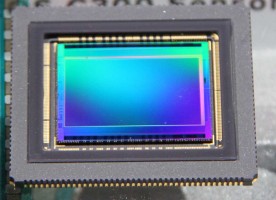 Larry Thorpe elaborated on the sensor. It seems revolutionary, in a new realm of secret sauces. He said,
Larry Thorpe elaborated on the sensor. It seems revolutionary, in a new realm of secret sauces. He said,
“The sensor is revolutionary in that it employs classic Bayer RGB color encoding of the single sensor photosites – but does not employ traditional demosaicing algorithms to decode these three video components. Rather it capitalizes on the dexterity of CMOS sensors that allow access to individual pixels to facilitate a novel extraction methodology that separately readouts the three sampling lattices of the RGB optoelectronic transformation.
“The Canon CMOS sensor is new. It uses a unique Bayer pattern, but we don’t de-Bayer, we reach down to the pixel level. So there are 1920 Red photosites, 1920 Blue, and 2x 1920 Green photosites. The green streams come from the sensor in parallel, and there’s a ½ pixel offset between the 2 green signals, h and v. This cancels aliasing, and provides very high MTF.”
Sensor is S35 3-perf: 24.4 x 13.6 mm. It’s a 4K x 2K Bayer, but they don’t de-Bayer—they use the extra resolution for color. This gets close to full RGB output Instead of de-Bayering, 4 adjacent photosites group into 1, so it doesn’t have to be average. There is a sample for every pixel, able to strip out pixel by pixel for full RGB value.
Here we get into tough territory. Why not 4K?
I think the reason is that Canon wanted to enter the digital motion picture market with a product that would immediately appeal to the majority of productions worldwide basis. That is currently 1920 x 1080 high definition video and 2K files for cinema. Most nonlinear editing systems support this, distribution is in place. Sources indicated that Canon is fully aware of the movement toward 4K production and they probably are preparing for it, ready to be released at an appropriate time. They did not provide a time frame. However, many of us remember seeing a working concept 4K camera at last year’s Canon Expo2010. So it’s probably not technology that is determining the schedule but rather business.
Furthermore, Larry Thorpe is quick to remind me that their new cine lenses were developed to be ready for 4K and significantly raise the bar when used on the C300 cameras.
Comparing Cameras
What is the difference between this camera and Canon’s 5D, 7D, and 1D X.
The DSLR cameras that were specifically designed primarily for digital still imaging – while adding HD motion video imaging. In terms of video performance, system interfaces, recording codec, and controls—they are not as sophisticated as the C300, and are comparatively less expensive.
Wrap up
What’s the big breakthrough for me with this camera? In two words: E.I. Exposure Index is high because of new innovations in the design of the photosite. Canon might be breaking new ground with this camera—perhaps a break-through between typical 35mm format production (features, TV drama, commercials) and into sports, news, documentaries. Remember, TV and news was once shot in 35mm long ago in the newsreel days—this might bring that back. The concern over focus and steadiness could be remedied by autofocus and image stabilization.
Canon appears ready to put out a great product and see where the market will take it. I think it will go far.

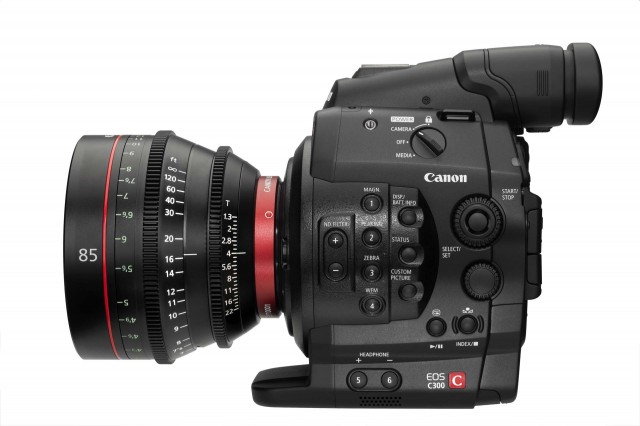
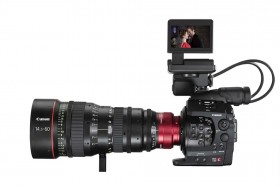
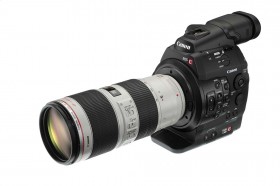
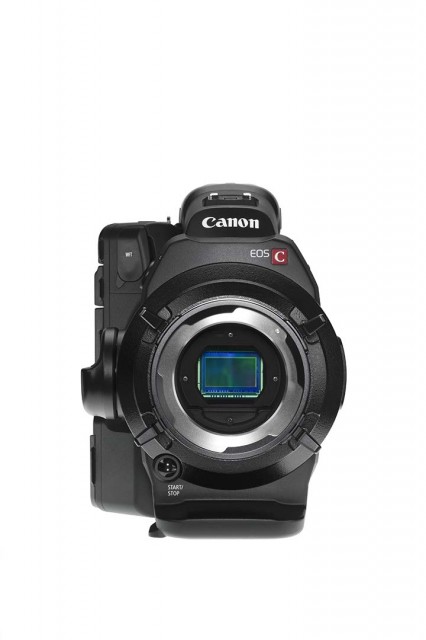
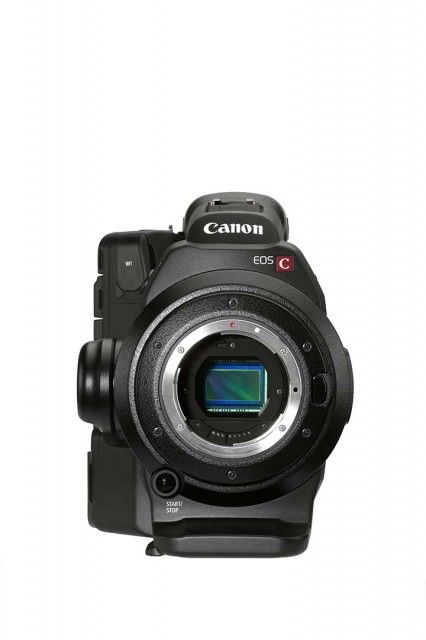
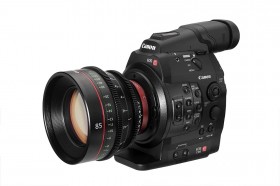
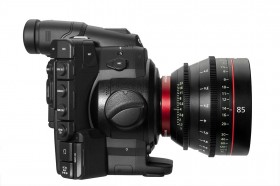
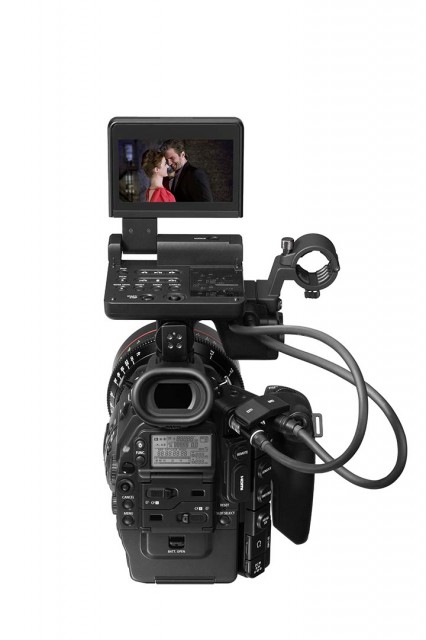
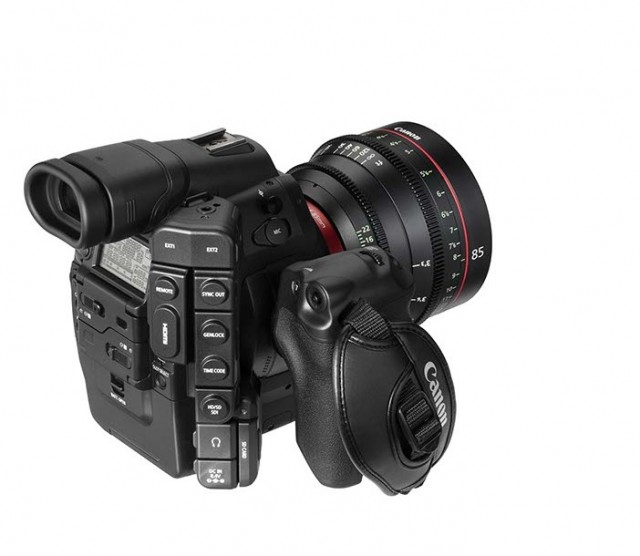
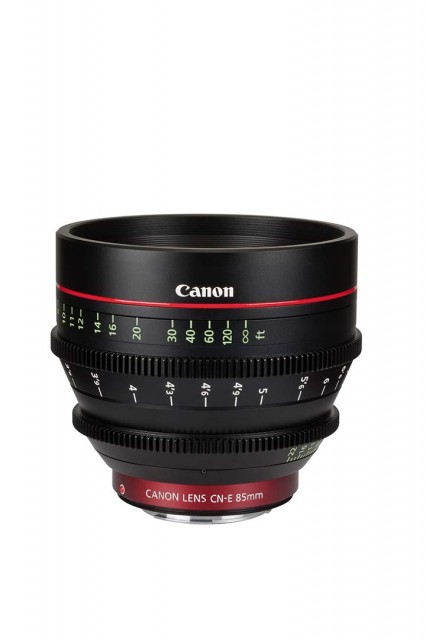
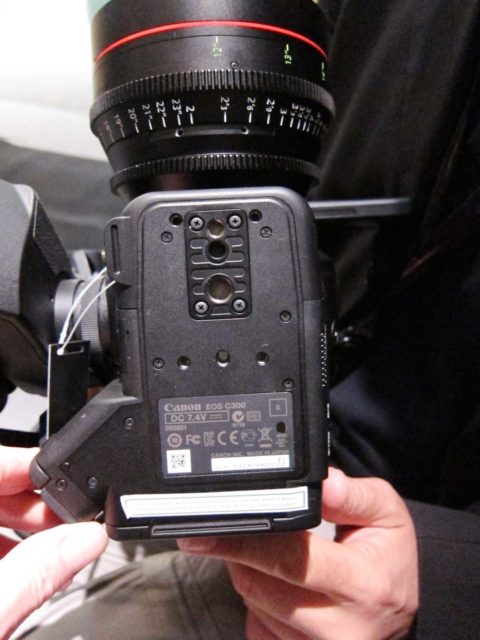
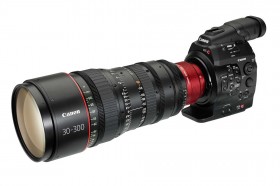
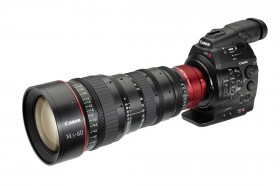


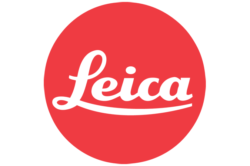






Pingback: Canon C300 Article Updated with Pictures | Film and Digital Times: News
Pingback: Voor hen die ook graag filmen... - Belgiumdigital forum - Digitale fotografie
Thanks Jon, that is great information. I read it when you posted and was frustrated to see just one picture… Today, I am in heaven!
Cheers,
Pierre
Glad to hear heaven is in France. Sorry for delay, Pierre–I was a little busy on stage moderating the Canon press conference. More pictures and posts to come.